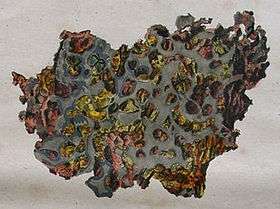Krasnojarsk (meteorite)
| Krasnojarsk | |
|---|---|
|
Hand-colored drawing | |
| Type | Stony–iron |
| Structural classification | Medium octahedrite |
| Class | Pallasite |
| Group | Pallasite Main Group |
| Country | Russia |
| Region | Krasnoyarsk Krai |
| Coordinates | 54°54′N 91°48′E / 54.900°N 91.800°ECoordinates: 54°54′N 91°48′E / 54.900°N 91.800°E[1] |
| Observed fall | No |
| Found date | 1749 |
| TKW | 700 kg |
Krasnojarsk was the first pallasite meteorite ever found.
History
A mass of about 700 kilograms (1,500 lb) was detected in 1749 about 145 miles south of Krasnoyarsk. It was seen by P.S. Pallas in 1772 and then, on his orders, transported to Saint Petersburg.
Krasnojarsk was the first pallasite meteorite ever found and studied and led to the creation of the Pallasite group, named after Pallas. It was also the first meteorite ever etched with acid (by G. Thomson) and therefore was the first one to show to human eyes the Widmanstätten pattern.
The main mass of 515 kilograms (1,135 lb) is now in Moscow at the Academy of Sciences.
Composition and classification

Krasnojarsk meteorite slice at the American Museum of Natural History.
It is a stony–iron meteorite of the Main Group Pallasite (MGP) group.
See also
References
External links
This article is issued from Wikipedia - version of the 7/22/2016. The text is available under the Creative Commons Attribution/Share Alike but additional terms may apply for the media files.
